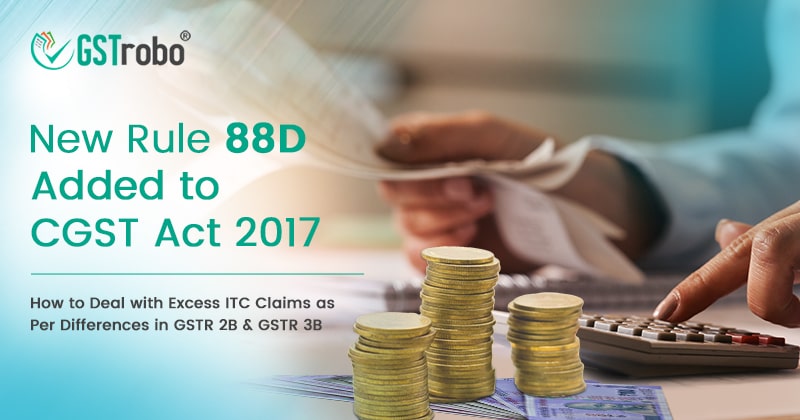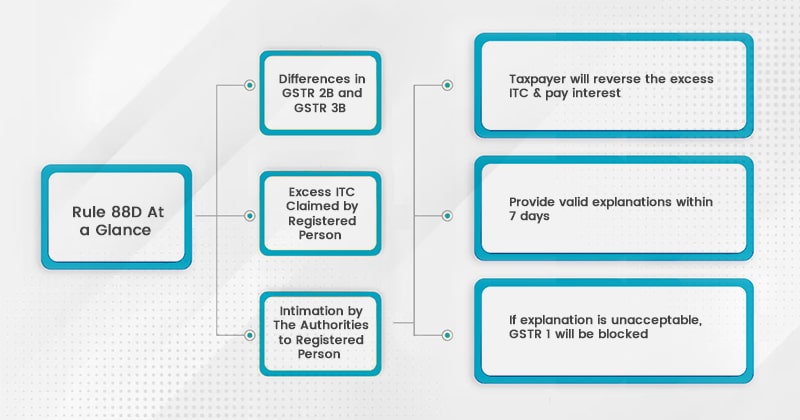Rule 88D: How to Deal with ITC Claims as Per Differences in GSTR-2B & GSTR-3B
A new rule 88D was recently added to the CGST Act, 2017, that explains the mandatory action required on the taxpayer’s end in case of there are differences in GSTR-2B and GSTR-3B and the taxpayer has taken excess or ineligible Input Tax Credit.

As per Notification No. 38/2023- Central Tax dated 4th August 2023 by authorities, this new regulation 88D is read with relevant FORM GST DRC-01C. It interprets the law regarding the failure by the taxpayer in providing an appropriate explanation for the above difference within the specified time and the subsequent consequences of this failure.
What is Rule 88D?
A taxpayer claims Input Tax Credit based on the reconciliation of the GSTR-2B and GSTR-3B. While the GSTR-3B is a self-furnished return statement by the registered person where they claim the ITC amount as per his books of accounts of outward supplies. On the other hand, GSTR-2B is an auto-generated statement that contains the details of the books of accounts of the buyer’s end.
For a supplier/ registered person to claim ITC, they must provide the reconciliation of his GSTR-3B, and the auto-generated GSTR-2B for a tax period or periods as per the law.
Rule 88D tells how the registered person must deal with the difference of amount in the actual ITC claimed, which is exceeding the Input Tax Credit amount generated in the registered person’s GSTR-2B. Here the taxpayer will be intimated by the authorities about the difference in ineligible Input Tax Credit amount in Part A of FORM GST DRC01C. The intimation will be available to him on the common GST portal and will be sent to him on the registered email address, highlighting the difference.
Action Required in Rule 88D on Excess/ Eligible ITC Claimed

The authorities mandate that the following action is required on the taxpayer’s end in case of a difference in the Input Tax Credit claimed amount and his GSTR-2B.
- Upon receipt of intimation in Part A of FORM GST DRC01C, the taxpayer must reverse the excess ITC he claimed in whole or part. He also must pay the interest payable under section 50 through FORM GST DRC-03. After the payment is complete, the taxpayer must furnish the details thereof in Part B of FORM GST DRC-01C electronically on the common portal.
- The registered person must explain the reasons for the difference mentioned above in the input tax credit still unpaid, if any. This explanation is done electronically on the common portal in Part B of FORM GST DRC-01C within seven days.
- If the registered person fails to provide the explanation for the excess ITC claimed or the provided explanation is not acceptable by the proper officer, the said amount shall be liable to be demanded under the provisions of section 73 or section 74 of the CGST Act 2017, as the case may be.
Repercussions of Non-Adherence of Rule 88D
Amendments are introduced in Rule 59(6) of the CGST Rules, 2017, to reprimand the registered person who fails to furnish a reply to the intimation received under the FORM GST DRC-01C within 7 days.
As a repercussion, the registered person cannot provide subsequent tax periods’ details of outward supplies of goods and services under section 37. They will not be allowed to file details in Form GSTR-1 or using the invoice furnishing facility.
This means that the taxpayer will not be able to file for further ITC claims or produce the details of his outward supplies in the GSTR-1 until and unless they reverse the excess ITC claimed by them. Alternatively, they must produce a valid reason behind the excess ITC claimed within a period of 7 days.
Reasons for The Difference in GSTR-2B and GSTR-3B
A. The taxpayer can select any of the following reasons to explain/ justify the excess ITC claimed as provided by authorities on the common portal:
B. Input tax credit not availed in earlier tax period(s) due to non-receipt of inward supplies of goods or services in the said tax period (including receipt of goods in instalments).
C. Input tax credit not availed in earlier tax period(s) inadvertently or due to mistake or omission.
D. ITC availed in respect of the import of goods, which is not reflected in FORM GSTR-2B.
E. ITC availed regarding inward supplies from SEZ, which are not reflected in FORM GSTR-2B.
F. Excess reversal of ITC in previous tax periods, which is being reclaimed in the current tax period.
G. Recredit of ITC on payment made to the supplier, in respect of ITC, reversed as per rule 37 in an earlier tax period.
H. Recredit of ITC on the filing of return by the supplier, in respect of ITC, reversed as per rule 37A in an earlier tax period.
I. FORM GSTR-3B was filed with incorrect details and will be amended in the next tax period (including typographical errors, wrong tax rates, etc.)
J. Any other reasons (need to be specified).
Conclusion
This new system-based intimation mechanism is a progressive approach to curb the increasing cases of negligent or wrongful ineligible Input Tax Credit claims. Similarly, the stricter law of Rule 88D helps handle the unwanted discrepancies in Input Tax Credit (ITC) between FORM GSTR-2B and FORM GSTR-3B in a more streamlined manner. This rule also ensures taxpayers report the exact values of ineligible ITCs for every tax period, making our GST system more transparent and efficient.
